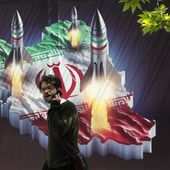OPINION:
The USS Gerald Ford projects American power
As an old Navy man who served as a young enlisted sailor on the aircraft carrier USS Kitty Hawk during the Vietnam War, I was pleased and proud to see the U.S. Navy’s newest aircraft carrier, the USS Gerald R. Ford (CVN 78), join America’s fleet.
Last month President Trump, Defense Secretary Jim Mattis and other dignitaries attended the commissioning of the USS Gerald R. Ford, the Navy’s latest nuclear-powered supercarrier, at the Norfolk naval base. The new carrier was named in honor of President Ford, who served on an aircraft carrier during World War II. His daughter, Susan Ford Bales, the ship’s sponsor, was also in attendance.
“The USS Ford is a magnificent warship that joins the best Navy in the world,” Mr. Mattis said at the ceremony. “It is named after a tried-and true member of the Greatest Generation, and that spirit will permeate this ship so long as it sails on the seas, as well as the U.S. Navy spirit of ’We have just begun to fight,’ ” he said.
Mr. Trump stated that a ship is only as good as the people who serve on it, and he said the American sailor is the best in the world.
“Among you are great welders, radar technicians, machine operators and pilots,” Mr. Trump said. “You take pride in your work and America takes pride in you. Wherever this vessel cuts through the horizon, our allies will rest easy and our enemies will shake with fear because everyone will know that America is coming and America is coming strong.”
“This ship is the deterrent that keeps us from having to fight in the first place,” he added. “But this ship also ensures that if a fight does come, it will always end the same way. We will win. We will never lose.”
Mr. Trump noted that possessing the best technology and equipment is only one part of America’s military might. He said that the people, the Ford’s crew, were the true strength.
“Our greatest weapon is all of you,” he told the crew.
In the past during a world crisis, the first question a president asked was: “Where are the carriers?”
According to the U.S. Navy, the aircraft carrier remains as the centerpiece of our forward-operating forces. Often the presence of an aircraft carrier has deterred potential adversaries from striking against U.S. interests. Aircraft carriers employ aircraft that engage in attacks on airborne, afloat and shore targets, as well as engage in sustained power projection operations in support of U.S. and coalition forces. The aircraft carrier and its strike group also engage in maritime security operations to interdict threats to merchant shipping and prevent the use of the seas for terrorism and piracy. Aircraft carriers also provide unique capabilities for disaster response and humanitarian assistance.
Aircraft carriers, of course, have their critics, and the critics often speak of the carriers’ vulnerability from land-based missiles and submarines.
Defenders point out that carriers are not so easy to hit. Carriers move continually at high speed on the great oceans of the world, so an adversary has to first locate and then track the fast-moving warship. And as carriers operate in multiship strike groups, an adversary would have to penetrate the carrier’s several rings of protection.
“A carrier battlegroup has an outer ring that consists of early warning, surveillance, and strike aircraft; these aircraft can be deployed in numbers and mixes depending on what the risk to the carrier is,” Lee Willett, head of the naval desk at IHS Jane’s, told FoxNews.com in 2015. “Below the surface there may be a submarine that is forward-deployed hundreds of miles ahead.”
“The next layers are the surface ships that include frigates, cruisers and then really close in are destroyers, and again under the surface could be another submarine, there to protect the carrier at close quarters,” Mr. Willett explained. “The battlegroup is like the layers of an onion. If an adversary ever managed to peel back the layers and get near the carrier at the core, the battlegroup would have done more than just make the adversary’s eyes water.”
Most arguments against aircraft carriers deal with all-out warfare, which, thankfully, we have not seen since 1945 and, hopefully, we never will see again. But since World War II aircraft carriers have operated successfully in conventional, non-nuclear wars such as the Korean War, the Vietnam War, and the wars in Iraq and Afghanistan, as well as in many other conflicts. And nothing was able to touch them.
At the Ford ceremony’s conclusion, Susan Ford Bales gave the order, “Man our ship and bring her to life.”
“The USS Ford is a 100,000-ton message to the world,” President Trump said.
Paul Davis is a writer who covers crime, espionage and terrorism.




Please read our comment policy before commenting.